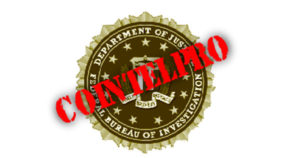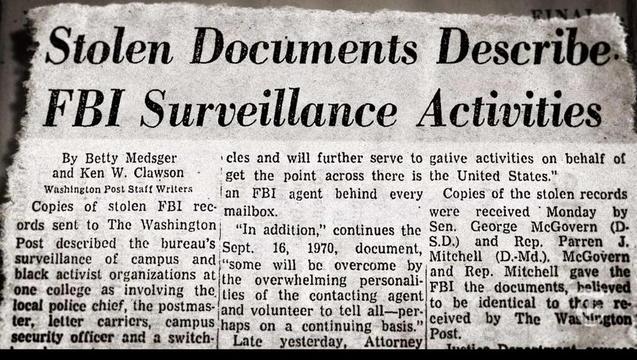
Good Morning POU!
This week we will look at the various tactics of the FBI in disrupting Black America through its infamous COINTELPRO program. Centralized operations under COINTELPRO officially began in August 1956 with a program designed to “increase factionalism, cause disruption and win defections” inside the Communist Party U.S.A. (CPUSA). Tactics included anonymous phone calls, IRS audits, and the creation of documents that would divide the American communist organization internally. An October 1956 memo from Hoover reclassified the FBI’s ongoing surveillance of black leaders, including it within COINTELPRO, with the justification that the movement was infiltrated by communists.
Most people readily identify COINTELPRO with the destruction of the Black Panther Party (BPP), however the program’s purpose was to destroy any and all individuals and institutions within the black community that focused on civil rights or activism of any sort. During the open threads this week, we will focus on all the program’s targets within Black America. First, we look at how COINTELPRO was discovered and exposed to the public.

According to attorney Brian Glick in his book War at Home, and based on the files discovered regarding the program, the FBI used five main methods during COINTELPRO:
1)Infiltration: Agents and informers did not merely spy on political activists. Their main purpose was to discredit, disrupt and negatively redirect action. Their very presence served to undermine trust and scare off potential supporters. The FBI and police exploited this fear to smear genuine activists as agents.
2)Psychological warfare: The FBI and police used myriad “dirty tricks” to undermine progressive movements. They planted false media stories and published bogus leaflets and other publications in the name of targeted groups. They forged correspondence, sent anonymous letters, and made anonymous telephone calls. They spread misinformation about meetings and events, set up pseudo movement groups run by government agents, and manipulated or strong-armed parents, employers, landlords, school officials and others to cause trouble for activists. They used bad-jacketing to create suspicion about targeted activists, sometimes with lethal consequences.
3)Harassment via the legal system: The FBI and police abused the legal system to harass dissidents and make them appear to be criminals. Officers of the law gave perjured testimony and presented fabricated evidence as a pretext for false arrests and wrongful imprisonment. They discriminatorily enforced tax laws and other government regulations and used conspicuous surveillance, “investigative” interviews, and grand jury subpoenas in an effort to intimidate activists and silence their supporters.
4)Illegal force: The FBI conspired with local police departments to threaten dissidents; to conduct illegal break-ins in order to search dissident homes; and to commit vandalism, assaults, beatings and assassinations. The object was to frighten or eliminate dissidents and disrupt their movements.
5)Undermine public opinion: One of the primary ways the FBI targeted organizations was by challenging their reputations in the community and denying them a platform to gain legitimacy. Hoover specifically designed programs to block leaders from “spreading their philosophy publicly or through the communications media”. Furthermore, the organization created and controlled negative media meant to undermine black power organizations. For instance, they oversaw the creation of “documentaries” skillfully edited to paint the BPP as aggressive, and false newspapers that spread misinformation about party members. the ability of the FBI to create distrust within and between revolutionary organizations tainted their public image and weakened chances at unity and public support.
How The Public Discovered “COINTELPRO”
On March 8, 1971 an anti-war activist group, the Citizens’ Commission to Investigate the FBI, broke into an FBI office in Media, Pennsylvania where they discovered a cache of classified documents, many bearing the cryptic code “COINTELPRO.”
They leaked the documents to the press and on March 24, 1971, The Washington Post ran a cover story on the vast program initiated by the FBI in 1956 to neutralize suspicious persons and organizations.
The Citizens’ Commission to Investigate the FBI was a leftist activist group operational in the US during the early 1970s. Their only known action was breaking into a two-man Media, Pennsylvania office of the Federal Bureau of Investigation (FBI), and stealing over 1000 classified documents. They then mailed these documents anonymously to several US newspapers to expose numerous illegal FBI operations which were infringing on the First Amendment rights of American civilians. Most news outlets initially refused to publish the information, as it related to ongoing operations and they contended disclosure might have threatened the lives of agents or informants. However The Washington Post, after affirming the veracity of the files which the Commission sent them, ran a front-page story on March 24, 1971.

The theft resulted in the exposure of some of the FBI’s most self-incriminating documents, including several documents detailing the FBI’s use of postal workers, switchboard operators, etc., in order to spy on black college students and various non-violent black activist groups.
The burglars did extensive surveillance of the FBI office, to ensure they knew when the office was empty. The break-in was perpetrated on the day of Joe Frazier and Muhammad Ali‘s Fight of the Century, in the hope that any security guards would be glued to their radios.
FBI had up to 200 agents working on the break-in, but it was never solved, and the investigation was closed when the five-year statute of limitations ran out.

The FBI closed their investigation into the group’s burglary on March 11, 1976 without conclusively identifying any of the perpetrators. The members’ identities remained a secret until early 2014, when all seven of the eight who could be found agreed to be interviewed by journalist Betty Medsger, who was writing a nonfiction book on the event: The Burglary. Of these seven, five agreed to be publicly identified: Keith Forsyth, John C. Raines and Bonnie Raines, and Robert Williamson; the recruiter and informal leader, William C. Davidon, died in 2013 before the book was published but had planned to reveal his involvement. The other two burglars who were interviewed for the hardcover edition chose to be identified by the pseudonyms “Susan Smith” and “Ron Durst”. The final burglar, Judi Feingold, had, unlike the others, fled across the country in 1971, and could not be found for 43 years. When she discovered that the other burglars were breaking their silence, she contacted Robert Williamson and eventually was interviewed by Medsger as well, which was included in the epilogue to the paperback edition of The Burglary.
Several months after the burglary, Keith Forsyth and Robert Williamson became members of The Camden 28, a separate activist group which broke into a draft board to destroy documents, in order to impede the war draft and make an anti-war statement.
Ten years prior to the burglary, John C. Raines was a member of the Freedom Riders.
Filmmaker Johanna Hamilton also made a documentary titled 1971.
